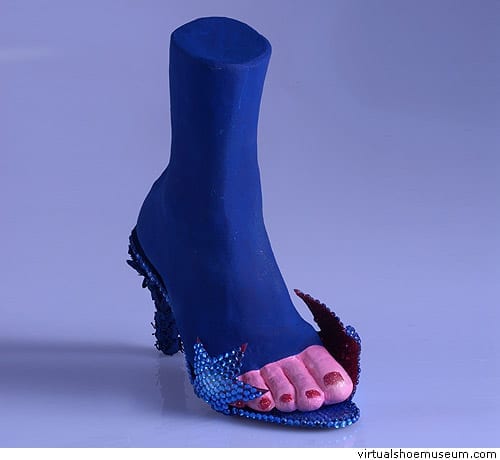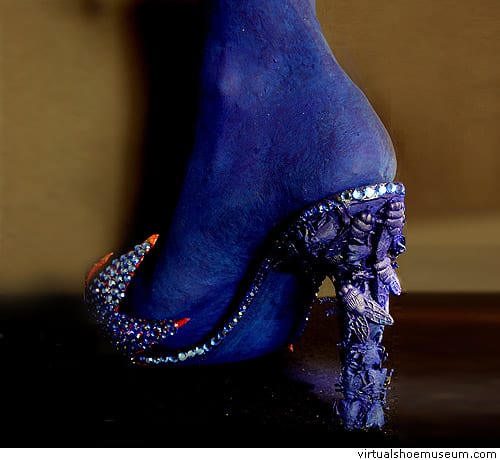This shoe sculpure is part of a series of 20 sculptures of shoes dedicated to the most relevant women in history, literature, cinema and comics. This project has been commissioned by Superstudio Milan and ANCI, and chosen as opening event for the MICAM 2006.
Isabella Rossellini (Dorothy Vallens)
This sandal is a personal tribute to my favourite artist David Lynch. Comic-strip writer, painter, screenwriter, director and sound designer. Among his many masterpieces I mention ‘Blue Velvet’ for it best represents the artist’s odyssey, compelled to mediate among the creativity, the exhausting search of funds to turn dreams to real and the anxiety for the economical returns linked to the producers. After the suffering of the financial setback for the film ‘Dune’, Dino De Laurentiis accepts to produce ‘Blue Velvet’ on the condition that the cost of the whole film wouldn’t go over five millions dollars and that Lynch would be disposed to work at minimum wage. The director obtained in exchange the full rights over the final cut. All films where Lynch was given freedom to create have been recognized masterpieces of screenplay and direction. In his films the attention for the detail become a circular element which is almost narrative and it stresses feelings as pathology, mechanical and repetitive banalities that are all characterized by violence of stability; automatized livings deprived of their own will but the one that create them and deads which wouldn’t leave the stage even also after being shot. Everything is well included into the compartments of life that keep going with its apparently primary needs, busy housewives stuffing turkeys, policewomen helping children crossing the road coming out of school, and pensioners watering gardens. Then the insects, alien clever creatures, thieves whose perfect nature allows them introducing every cavity, always present in every story of David Lynch. In Blue Velvet, after a running shot upon the “quiet life” of Lumberton, the cine-camera take a while before getting into the darkness of a terrible pile of bugs swarming inside a human ear. It belongs to Dorothy Vallens’ husband (Isabella Rossellini) singer in a night club, and is found by the young Jeffrey , who will play the detective to solve a case which will let him to keep touch with his innermost perversions. These perversions are what none or less all the protagonists of the movie will have to deal with, between eye games and sudden changes. Switching from victims to torturers in a few seconds during the same shot, nobody’s wants to actually draw attention, and therefore be judged in the act of satisfying their innermost desires. Isabella’s heels are entirely covered of bugs, whereas in the film they enter the ear. There are no bugs on her foot and this is my “happy” ending of the film; the camera frames a “living” ear and a robin, symbol of love, holds a cockroach in its beak as to symbolize a moment of truce that sounds like an armed peace. At the “Slow Club”, the night where Dorothy works, she sings two songs, “Blue Velvet” and “Blue Star”. The sandal’s vamp exactly draws two stars and they are made in PET, instead of velvet as the film might suggest, for it is deepest referral to the original director’s intents. In fact, incredible secrets inhabits into the “everyday” hidden by evidence. The PET bottle is everyday under everybody’s eyes and it is so evident to become, by absurd, invisible. It is the classic water container you can find on every table of the world, in the everyday reality that is also made of dirty business kept in the family till the cloth get so soaked that needs washing directly at the police-office. At that stage it is just crime news. Black. Blackest. As a cockroach’s back.
Courtesy of Daniele Fontana at Whitenoisephotography 2007.

